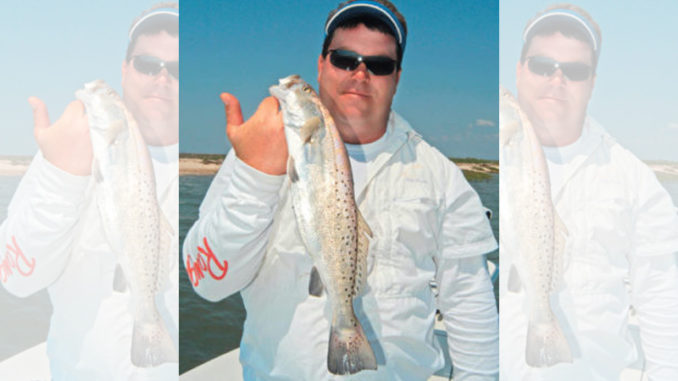
April action in this sprawling marsh area makes a longer drive worth the extra miles.
Rob Beglin of Inshore Xtreme Guide Service lives in Pawley’s Island, but when he takes parties fishing, he drives a good 45 minutes south to the Cape Romain/Bulls Bay area.
In doing so, he trailers his flats boat right past North Inlet, Winyah Bay and the North and South Santee rivers — all popular fishing destinations for anglers targeting redfish and speckled trout.
There must be something about the sprawling marshes and tidal creeks that crisscross the Cape Romain National Wildlife Refuge that’s worth the extra highway time and gasoline required to pass up some mighty good water, right?
“The Bulls Bay-Cape Romain area is second only to Louisiana. Is that stretching it a little?” Beglin asked rhetorically. “There are plenty of fish, and you couldn’t fish it all in a lifetime; plus, you won’t see five boats all day.”
Spring is a transition time for fish here
Spring is a transition time for many fish, with the water warming and baitfish and shrimp starting to stir. Beglin (843-458-1920) said reds will scatter out in the spring, searching for bait instead of staying in smaller areas, and trout will begin to stir, heading toward their prime months of May and June.
“When the water warms up into the mid-50s, that’s when the schools of redfish start breaking up, and that’s usually the first part of April,” he said. “They’ll move into singles and twos and threes. You won’t find ’em in big schools anymore. They’ll be out roaming, looking for bait and enjoying the warming weather.
“The trout bite gets started in April,” he said. “Normally, you’re looking at three hours before high tide to three hours after — that 6-hour stretch — for trout.”
Beglin fishes a Gulp! shrimp on a jighead when the water’s cool or when he’s sight-fishing up on the flats for tailing reds on flood tides.
“I rely on that pretty much all winter; that’s what I fish for reds,” he said. “I don’t throw a Gulp! shrimp as much in the summer; I’ll fish a Redfish Magic (spinnerbait) or a gold Johnson spoon.”
Five Fathom Creek is basically the dividing line between the Cape Romain area and the Bulls Bay area to the south. Buck Hall Landing in the Francis Marion National Forest is the closest public access; a $5 day-pass fee is charged. The town of McClellanville operates a ramp, but an annual fee is charged.
A. Cape Island Flat
N 32 02 132/W 79 21 117
This is one of Beglin’s best spots for catching over-slot reds, fish between 27 and 33 inches. A long flat, covering several hundred yards, he fishes the entire length of it through the winter and spring.
“It’s a big flat, and the ocean is right across the dunes,” he said. “On high water, they’ll be up on the bank. On low water, they’re scattered along the whole bank.”
Beglin’s favorite baits on flats like this one are a Redfish Magic spinnerbait or a gold Johnson spoon.
“The spoon is pretty much our go-to bait, especially when you can’t get ‘em to hit anything else,” he said.
B. Cowpen Point
N 33 02 231 / W 79 21 663
The point, which features a single, long dock, is just a place to start, as it separates two long flats that are normally full of redfish.
“I’ll fish the flat on the north side of the point, all the way back in the pocket,” Beglin said. “It’s nothing but grass and oysters for 500 yards.”
Beglin fishes the flat on the north side of the point on a south or southwest wind. On a north or northeast wind, he fishes the right side.
“I usually start on the end of the flats and fish back to the point,” he said. “It’s a lot easier to get onto the flat on the north side from the other end.”
C. Mill Island
N 33 02 537 / W 79 22 114
Mill island is one of Beglin’s favorite spots to leave his boat and wade for redfish on flood tides, but the bank is also a great spot to catch speckled trout.
“You see where the water flows over the bank on high water and fish that side accordingly,” he said. “On low water, get back in the pocket.
“Oysters run the entire length of the island, 10 feet off the bank, and in the winter, the redfish will run in there to get away from dolphins.”
Beglin said most fishermen who like to fish bait will float a live shrimp (if available) under a popping cork, but he fishes artificials almost exclusively and will fish a Saltwater Assassin grub on an eighth-ounce jighead.
“I don’t go to a quarter-ounce head because it sinks too fast and you get hung up in the oysters too much,” he said. “But you want to throw any kind of plastic that’s got a chartreuse tail.”
D. Devil’s Den
N 33 02 397 / W 79 22 446
This is a great spot to fish on a falling tide, according to Beglin, who advises to start fishing in the mouth of the smaller feeder creek and around to the north, into Horseshead Creek.
“It usually holds a lot of redfish, and a lot of people don’t fish it,” he said. “It’s predominately shell on the bank; when you get off the bank, it’s a mud flat.”
Beglin typically works his way down the bank, covering a lot of water with a Redfish Magic spinnerbait or a Gulp! shrimp on a jighead.
E. Lighthouse Island
N 33 01 486 / W79 23 029
A small creeks snakes its way out into the Romain River, draining much of the marsh on Lighthouse Island. Begin said there’s a 6- to 8-foot shelf in front of the creek, but the big drawing card is the creek itself.
“If winds back in there about a mile-and-a-half, and it flattens out,” he said. “It’s an incredible tailing flat. The creek is really good on a flood tide; you just go back and fish both sides.”
When he’s sight-fishing for tailing reds on a flood tide, he’ll dead-stick a Gulp! shrimp on a jighead.
“I just try to sort of lead them and put it in front of where I think they’re going,” he said. “If I’ve got somebody fishing with me that’s not a good target caster, I’m going to give them a gold spoon; they’ll pick up some fish on it.”
F. Deepwater Point
N 33 03 808 / W 79 22 274
The mouth of a small drain creek midway between the mouth of Horseshead and Casino creeks is just the starting point for Begin, who fishes the entire length of the bank.
“It’s great all along for flounder, trout and redfish,” he said. “It’s one of the first spots we go on high water for trout and flounder.
“The whole bank from Horseshead Creek to Casino Creek is a white oyster shell bank. It predominately holds trout, and we’ve worn ’em out on this bank. At low tide, it holds three feet of water, and on high tide, it’s 7- to 8-feet deep.
“On that entire bank, I’ll normally fish a Saltwater Assassin,” Beglin said. “I’ve had more success with that lure on that bank than anything else.”
G. Congaree Boat Creek MOUTH
N 33 03 899 / W 79 36 822
Beglin said the point on the northeast side of the creek mouth is a great place to fish for speckled trout on a northeast or west wind.
“There’s a steep ledge and a lot of shell on the bank,” he said. “There’s a good current, but it’s sheltered, and it doesn’t get too muddied up.
“I fish 300 yards on either side of the point, and I always fish it on a falling tide,” he said. “I usually fish it with a grub.”
H. Small Island Off Horsehead Island
N 33 02 495 / W 79 24 545
This small island is just across Horsehead Creek from a firetower at the mouth of a ditch that connects Horsehead and Congaree Boat creeks.
“This is one of the lowest-lying islands,” Beglin said. “I fish all the edges of the island and its west side. The two grass points are great on high water for trout. Reds will come around the backside, toward Horseshoe Island.
“I like to get out and wade the little island.”
I. Muddy Bay Oyster Racks
N 33 03 984 / W 79 25 157
The oysters are concentrated on the right-hand bank going north out of Muddy Bay into Clubhouse Creek.
“Mostly, you fish in back of the rakes on low water; you just putter along,” Beglin said. “The redfish will be in-between the rakes and on the back side of them, where they can get up on the flat to get away from the dolphin.”
Beglin said it’s a great summertime spot, because the prevailing winds blow a lot of bait onto the bank. He’ll fish it with a Redfish Magic spinnerbait or Johnson gold spoon.
“It must be a good spot,” he said. “A lot of guides fish there.”
J. McClellanville ICW Bank
N 33 04 682 / W 79 27 322
This is an excellent bank, and Beglin fishes it all the way from the mouth of Clubhouse Creek to the mouth of Five Fathom Creek.
“It’s a deep, shell bank, and there’s a trough that lays in there close to the bank,” Beglin said. “You’ll catch a mixture of trout and reds along the bank, but mostly reds.
“If fish it with a grub pretty much all the time, because I usually fish this bank on high water,” he said. “I don’t fish it on low water very often.”

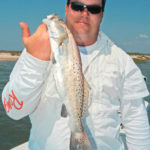
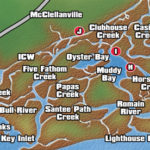
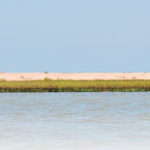
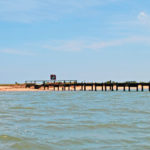
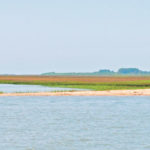
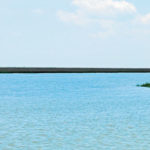
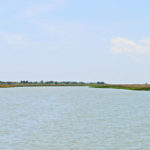
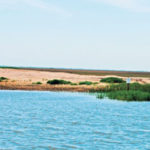
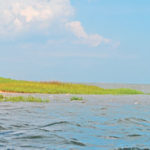
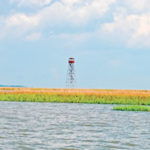
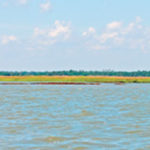
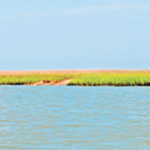

Be the first to comment